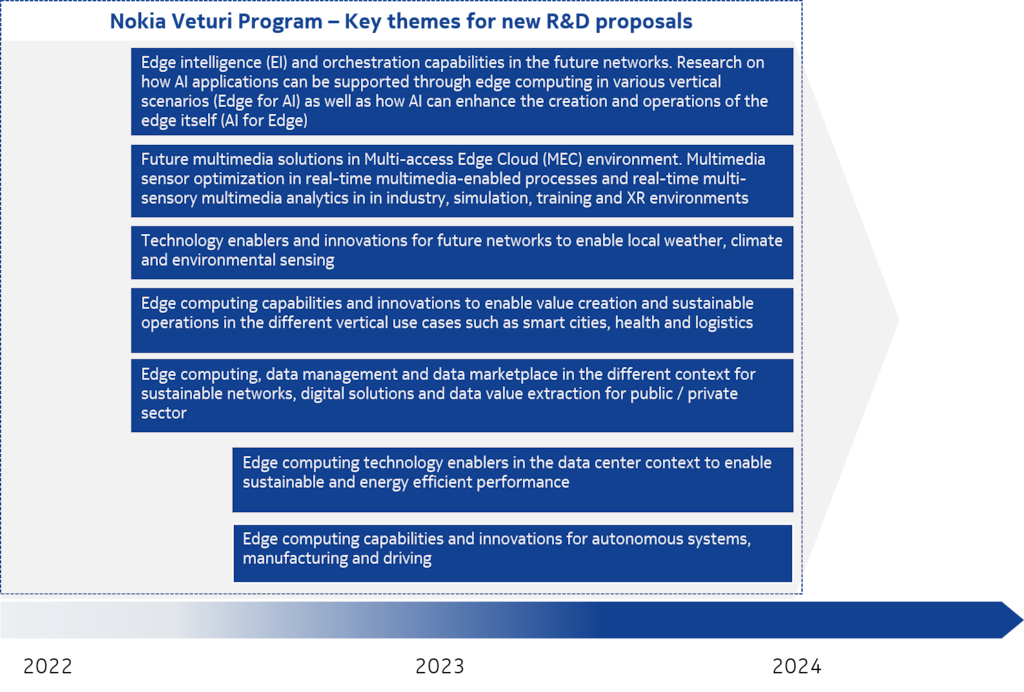Nokia Veturi program: Competitive Edge
Creating COMPETITIVE EDGE for sustainable future networks
As modern networks continue to evolve towards 5G and the Internet of Things (IoT), there is an essential need to manage very rapidly increasing data transfer and network capacity requirements to provide low latency services and increase capacity in a sustainable way. Edge computing and edge intelligence are considered an essential element in 5G networks. They both represent a key enabling factor for future sustainable digital infrastructure and networks. For example, optimization of workloads can significantly reduce energy consumption related to data transport.
Nokia’s Veturi program mission is built on the following three pillars, which together strengthen Finland’s role on research and development:
- Sustainability and competitiveness: edge computing can significantly improve energy efficiency, data security, and privacy on the digital infrastructure. Cloud computing is transforming the telecoms landscape, offering Communications Service Providers (CSPs) flexibility, lower overall costs and high service availability to meet the growing demands on networks, sustainability, new applications and data by consumers and enterprises. It will also open up significant business opportunities for the new edge application developers.
- Network scalability and operability: Edge computing enable massively distributed, automated, cloud-native and secured basis across geographically diverse locations making latency-sensitive applications and digital services sustainable and energy efficient.
- Solution Focus: Co-innovation and co-development among CSPs, webscalers and network technology companies is essential to create edge-based global solutions that enable sustainable and automated data transfer across future digital infrastructure for consumers and enterprises in every industry. With well-created ecosystem initiatives, effective sectoral integration of core competences and with a common roadmap in Finland we have a unique global position to grow new global multi-billion level businesses.
Competitive Edge in a nutshell
- Business Finland funded 3‑year program
- Program started in January 2022, ending in December 2024
- Program size of 70 MEUR

Roadmap
Together with a large number of ecosystem partners, Nokia will create a significant impact on R&D investments in Finland during the coming years. It will strongly support the governmental target to increase R&D expenses to four percent of GDP. Finland has strong expertise in many fields of ICT, sustainability, energy efficiency and digital solutions and Nokia has a strong ambition to create a strong ecosystem in Finland on edge capabilities enabling strong global growth for companies and increasing investments in Finland.
[click on the image to enlarge]
This program will strengthen the position of Finnish edge ecosystem in global markets and create sustainable competitive edge for Finnish ecosystem and platform to develop new innovative solutions, and Nokia is looking forward to collaborate with a large number of ecosystem partners and with Business Finland in our new Veturi program.
Highlights
projects
ecosystem partners
Ecosystem R&D investment increase

Started co-innovation projects
XR Space
XR Simulation and Presence at the Cloud Edge
Objectives
Project has two main objectives: create and develop multi-dimensional analytics of vehicles perating in professional environments (e.g. in heavy, air and maritime transport). Applications of interest include both simulated and real operating environments. The second objective is to connect remote people virtually with photorealistic volumetric video communication system that support real-time holographic interaction between multiple participants (e.g. in remote meetings, maintenance, training and operation).
Project has two main objectives: create and develop multi-dimensional analytics of vehicles perating in professional environments (e.g. in heavy, air and maritime transport). Applications of interest include both simulated and real operating environments. The second objective is to connect remote people virtually with photorealistic volumetric video communication system that support real-time holographic interaction between multiple participants (e.g. in remote meetings, maintenance, training and operation).
Creanex, Finnair, Groke Technologies, Metropolia, Pohjola Insurance, SAAB Finland, Softability Xreach, Taipale Telematics, Tampere University, Varjo & Viaccess-Orca Finland
Jukka Saarinen, jukka.saarinen [at] nokia.com
SmartE3
IoT based Building energy system powering Sustainable Energy Use
Objectives
- Design principles for modular local energy system architecture, technology portfolio and dimensioning.
- Business model for local energy community that is creating optimal value for local generation and flexibility.
- Optimal control of resources based on the forecasting of the generation and loads and flexibility.
- Edge computing, Data-analytics, Machine learning, Artificial intelligence, IoT and related communication solutions, utilization and deployment of 5G technology and edge computing.
- Design principles for modular local energy system architecture, technology portfolio and dimensioning.
- Business model for local energy community that is creating optimal value for local generation and flexibility.
- Optimal control of resources based on the forecasting of the generation and loads and flexibility.
- Edge computing, Data-analytics, Machine learning, Artificial intelligence, IoT and related communication solutions, utilization and deployment of 5G technology and edge computing.
Lappeenranta-Lahti University of Technology LUT, LSK Group Oy & Rossum Oy
Samuli Honkapuro, samuli.honkapuro [at] lut.fi
QLeap
Containers as the Quantum Leap in software development
Objectives
The goals of the project include guidelines for using containers* in general as elements of architecture design, outside generic cloud environments. Such systems include containerized AI systems, with GDPR and EU data & AI acts in mind. security properties in inter-container use, regulated use of containers, embedded systems, which require small memory footprint containers, and using containers in hybrid setup (public/hybrid/private clouds).
The goals of the project include guidelines for using containers* in general as elements of architecture design, outside generic cloud environments. Such systems include containerized AI systems, with GDPR and EU data & AI acts in mind. security properties in inter-container use, regulated use of containers, embedded systems, which require small memory footprint containers, and using containers in hybrid setup (public/hybrid/private clouds).
Bittium, M-Files, Solita, Vaadin & Jyväskylä University
Tommi Mikkonen, tommi.j.mikkonen [at] jyu.fi
Industry X
Driving Twin Transition with edge-enabled research
Objectives
-
Strengthening Finnish companies and academia in becoming global leader in edge-enabled research and technology in chosen industry domains.
-
Demonstrating efficiency and business potential in applying AI, multimedia, edge computing and 5G in industry.
-
Strengthening Finnish companies and academia in becoming global leader in edge-enabled research and technology in chosen industry domains.
-
Demonstrating efficiency and business potential in applying AI, multimedia, edge computing and 5G in industry.
Fastems, Glaston, Pemamek, Prima Power, Raute, Vacon, Vaski, Tampere University
Jukka Saarinen, jukka.saarinen [at] nokia.com
DataMust
Data markets for sustainable cities
Objectives
The DataMust project study a local cell-based edge data marketplace concept for providing a vertically agnostic approach with high horizontal connectivity.
This concept will enable the building of federated service-based solutions that bring all urban actors together to productise, enrich, share, refine, and trade data for maximizing the Sustainable Development Goals impact.
The DataMust project study a local cell-based edge data marketplace concept for providing a vertically agnostic approach with high horizontal connectivity.
This concept will enable the building of federated service-based solutions that bring all urban actors together to productise, enrich, share, refine, and trade data for maximizing the Sustainable Development Goals impact.
Loihde, Sitowise, Cozify, Coba, VTT, nollaE, City of Århus, City of Espoo and City of Tampere
Juha Salmelin, juha.salmelin [at] nokia.com
NeMEco
Next generation mining and heavy machinery 5G business models and ecosystems
Objectives
The overall aim of the project is to bring forward perspectives on the value-creation logic of 5G technology-enabled innovation ecosystems, with a primary focus on mining and heavy machinery industries.
The overall aim of the project is to bring forward perspectives on the value-creation logic of 5G technology-enabled innovation ecosystems, with a primary focus on mining and heavy machinery industries.
Åbo Akademi University (School of Business and Economics), Sandvik, Junttan, Kalmar, Sustainable Industry X (SIX) ecosystem members, Sprott School of Economics at Carleton University, USN School of Business, University of South-Eastern Norway, University of Auckland Business School, Imperial College London
Jarkko Pellikka, jarkko.pellikka [at] nokia.com
Learn more

Website
Open Ecosystem Network
Open communities brings together the most ambitious companies and bright individuals

BF web page
Business Finland: Funding for leading companies and ecosystems
Business Finland challenges global companies to lead ecosystems that consist of companies of different sizes and other players.
Contact our Veturi team:
Jarkko Pellikka, jarkko.pellikka [at] nokia.com, tel: +358 40 7239 779
Veli-Pekka Luoma, veli-pekka.luoma [at] nokia.com, tel: +358 40 5743 489

